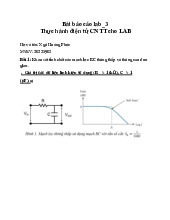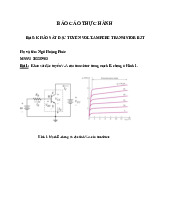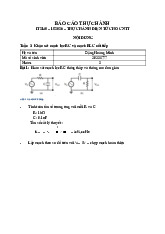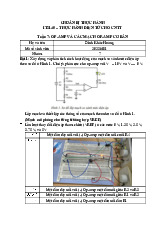



















Preview text:
2016 2021 Electronics Electronics Class hours: 4h/week
Tutor: Assoc. Prof. Dr. Nguyen Tien Dzung
Add: 94 Le Thanh Nghi Street, Tai-chuc Area, Building C, Room 102 Mobile: 0988.355.343
Email: dzung.nguyentien@hust.edu.vn
Department: Electronics and Computer Engineering
Hanoi University of Science and Technology
School of Electronics and Telecommunications 2016 2021 Electronics Course outline
Chapter 1. Basic introduction about electro-electronics
Chapter 2. Semiconductor devices
Chapter 3. Pulse curcuits
Chapter 4. Digital logic and circuits
Hanoi University of Science and Technology
School of Electronics and Telecommunications 2016 2021 Electronics Reference
1. Nguyen Tien Dzung, “Fundamentals of electro-electronics circuits,” 1st edition,
Bach khoa publishing house, ISBN 9786049110009, 2010.
2. Thomas L. Floyd, “Electronics devices,” 7nd edition, Prentice Hall Publisher, 2005. Used software
Circuit maker 2000: Recommend using this software for an easy cross-check
Hanoi University of Science and Technology
School of Electronics and Telecommunications 2016 Electronics 2021 Course requirements
1. Class participation (PR) 5% 2. Homework (HW) 10% 3. Presentation (PR) 15% 4. Final test (FT) 70%
Hanoi University of Science and Technology
School of Electronics and Telecommunications 2016 2021 Electronics Course requirements
1. Class participation (PR) 5% 2. Homework (HW) 10% 3. Presentation (PR) 15% 4. Final test (FT) 70% Notes for online class
1. Join in class link at least 10 minutes before the start, and test
microphone + camera mounted on your device.
2. Raise your hand if you have comment during class.
3. Turn on camera and unmute to answer questions or share you comments if allowed.
4. Read in advance lecture note uploaded in class teams before each class.
5. Complete quick tests, HW etc … as required by the tutor.
Hanoi University of Science and Technology
School of Electronics and Telecommunications
Chapter 1. INTRODUCTION
The purpose of the first chapter is to introduce some fundamental
concepts and terminology which will be used through the book. In
particular, we shall learn about signals and about one of the most important
signal-processing functions electronics circuits are designed to perform,
namely, signal amplification. We shall then look at models for linear
amplifier. These models will be employed in subsequent chapters in the
design and analysis of actual amplifier circuits.
Whereas the amplifier is the basic element of analog circuits, the logic
inverter plays this role in digital circuits. We shall therefore take a
preliminary look at the digital inverters, its circuit function, and important characteristics.
In addition to motivating the study of electronics, this chapter serves
as a bridge between the study of linear circuits and that of the subject of this
book: the design and analysis of electronic circuits.
1.1. FUNDAMENTAL PARAMETERS
1.1.1. Voltage and current a. Voltage
Originating from the point of view in physics, a voltage is defined as
the difference between the potentials of two arbitrary points in electronics circuits: U
= U −U (1-1) AB A B
where U and U are the potentials of two points A and B in a circuit A B
towards the ground. As another definition, a voltage is determined as the
electrical "pressure" that causes free electrons to travel through an electrical
circuit. It is also known as electromotive force (emf) and measured in volts
(V). Usually, one location in the circuit is selected as the ground which has zero potential.
Kirchoff’s voltage Law (KVL) 1
The KVL states that the voltages between the two end-points of
parallel connected components are equal. From this fact, the sum of
potential falls Ui on i-th component in a loop of a circuit is equal to zero. That means: U = 0 (1-2) i i b. Current
A current is defined as the amount of electrical charge or the number
of free electrons moving across a given point in an electrical circuit per unit
of time and measured in amperes (A). If a circuit is broken at any point, the
electric current will cease in the entire loop, and the full voltage produced
by the battery will be manifested across the break, between the wire ends
that used to be connected. When a voltage source is connected to a circuit,
the voltage will cause a current through that circuit which is directed from a
point with higher potential to the one with lower potential. That means the
current is reversely directed to the direction of electron flow.
Kirchoff’s current Law (KCL)
In one loop of a circuit, the amount of electrical charge at any point is
the same as the amount of electrical charge at any other point. Therefore, the
KCL states that an arithmetical sum oxaf the currents Ii coming into a node
and out from that node are equal to zero. I = 0 (1-3) i i
A circuit is directed from a point with a high potential to the one with
lower potential in a circuit. That means it is reverse to the moving direction of the electrons.
1.1.2. Independent and dependent sources a. Source
A source is an element or a device which can generate a voltage or a
current. A source can be represented either as a voltage or current sources
depending on its internal resistance. b. Independent sources 2
1. Voltage source:
An ideal source Usource has zero internal resistance Rsource, so that
change in load resistance Rload will not change in voltage supplies Esource. In
general, a real source is defined as: Rload U = E (1-4) source sup ply R + R source load
2. Current source:
An ideal current source Isource has infinity internal resistance so that
changes in load resistance will not change in current supplies. A real source: Rsource I = I (1-5) source source R + R source load
3. Relation between voltage and current sources:
From equations 1-4 and 1-5 above, relation bitween can be acrived as: Esource I = (1-6) load Rsource U = I R (1-7) load source source c. Dependent sources
In real circuits, the dependent sources considered in Figure 1-4 play
the role of amplifiers. From Figure 1-4 thee sources are represented as
amplifier circuit models and we can observe that the input resistance R1 of
the given amplifiers can be determined by applying an input voltage and
measuring the input current. The output resistance is found as the ratio of
the open-circuit output voltage to the short-circuit output current.
Alternatively, the output resistance can be found by eliminating the input
signal source and applying a voltage signal to the output of the amplifier.
The amplifier models considered above are unilateral. That is, signal
flow is unidirectional, from input to output. Most real amplifiers show some
reverse transmission, which is usually undesirable but must nonetheless be modeled.
1. Voltage source controlled by a voltage (VV): Voltage amplifier 3 R2 U1 X U2 = k.U1 U1 R U2 = k.U1 1 a. b.
Figure 1-1. Voltage source controlled by a voltage
a. Ideal source; b. Real source
2. Voltage source controlled by a current (VC): Transresistance amplifier R2 I1 U I1 2 = r.I1 U2 = r.I1 R1 a. b.
Figure 1-2. Voltage source controlled by a current
a. Ideal source; b. Real source
3. Current source controlled by voltage (CV): Transconductance amplifier U1 X I2 = g.U1 U1 R1 R1 I2 = g.U1 a. b.
Figure 1-3. Current source controlled by voltage
a. Ideal source; b. Real source
4. Current source controlled by a current (CC): Current amplifier I1 I I1 2 = α.I1 R1 R1 I2 = α.I1 a. b.
Figure 1-4. Current source controlled by a current
a. Ideal source; b. Real source 4
1.1.3. Linear and non-linear elements
a. Resistor ( R )
Special components called resistors are made for the express purpose
of creating a precise quantity of resistance for insertion into a circuit. They
are typically constructed of metal wire or carbon, and engineered to
maintain a stable resistance value over a wide range of environmental
conditions. Typically, the purpose of a resistor is not to produce usable heat,
but simply to provide a precise quantity of electrical resistance, which is
measured in Omh ( ). In other word, the resistance is defined as the
property of a resistor to oppose the flow of electrical current through itself.
Regarding resistor R, voltage U and current I in a circuit, there are some
useful relations as given below:
1. Ohm’s Law:
U = I R (1-8) U or R = (1-9) I
2. Electric power: 2 U 2
P = U I = I R = (1-10) R
3. n resistors in parallel: n
Current flow in each resistor: I = I (1-11) i i=1
Voltage drop over each resistor: U = U = = U (1-12) R R 1 2 n R n 1 1 Equivalent resistance: = (1-13) R 1 R total i= i
4. Current divider formula fo two resistors R1 and R2 in parallel:
The current flow in each resistor: R2 I = I (1-14) 1 R + R 1 2 5 R1 I = I (1-15) 2 R + R 1 2
5. n resistors in series: n
Voltage between A and B end-points: U = U (1-16) AB i i=1
Current flow in each resistor: I = I = = I (1-17) R R 1 2 n R n
Equivalent resistance: R = R (1-18) T i i=1
6. Voltage divider formula in case of two resistors in series: R1 U = U (1-19) 1 AB R + R 1 2 R2 U = U (1-20) 2 AB R + R 1 2 b. Inductor (L)
A component having the property to oppose any change in current
through itself, by storing and releasing energy in a magnetic field
surrounding itself is called inductor and typically denoted by L. An
inductor's ability to store energy as a function of current results in a
tendency to try to maintain current at a constant level, and therefore it is
called inductance and measured by Henry (H). When current through an
inductor IL is increased or decreased, the inductor "resists" the change by
producing a voltage UL between its leads in opposing polarity to the change.
This relation can be expressed by the following equations: dI
Voltage drop over an inductor L: U = L L (1-21) L dt 1 I = (1-22) C U dt L L
c. Capacitor (C)
A component having the property to oppose any change in voltage
across its terminals, by storing and releasing energy in an internal electric
field is called capacitor and typically denoted by C. A capacitor's ability to 6
store energy as a function of voltage results in a tendency to try to maintain
voltage at a constant level, and therefore it is called capacitance and
measured in Farad (F). In other words, capacitors tend to resist changes in
voltage drop. When voltage across a capacitor is increased or decreased, the
capacitor "resists" the change by drawing current from or supplying current
to the source of the voltage change, in opposition to the change. This
relation can be expressed by the following equations: dU I = C C (1-23) C dt 1 U = (1-24) C I dt C C
1.2. INFORMATION AND SIGNALS 1.2.1. Definition
Signals contain information about a variety of things and activities in
our physical world. To extract required information from a set of signals,
the observer invariably needs to process the signals in some predetermined
manner. This signal processing is usually performed by electronic systems.
However the signal must be converted into an electric signal, that is, a
voltage or current by using devices called transducers. The information is represented by a signal.
Signals may fall into two categories: analog and digital. An analog
signal is continuous in time and analogous to the physical signal that it
represents. The magnitude of an analog signal exhibits a continuous
variation over its range of activity. Electronic circuits that process such
signals are known as analog circuits.
A digital signal is an alternative form of signal representation as a
sequence of numbers, each number representing the signal magnitude at an instant of time.
The conversion between the two categories of signals can be done by
analog-to-digital converter (ADC) or digital-to- analog converter (DAC). 7
1.2.2. Signal presentation
From the discussion above, it should be apparent that a signal is the
time-varying quantity that can be represented as a continuous signal as
shown in Figure 1-5. In fact, the information content in the signal is
represented by the changes in its magnitude as time in progresses. In
general, such waveforms are difficult to be characterized mathematically. In
other words, it is not easy to describe succinctly an arbitrary-looking
waveform such as that in Figure 1-2. Of course, such a description is of
great importance for the purpose of designing appropriate signal-processing
circuits that perform desired functions on the given signal. S(t) Time, t .
Figure 1-5. An example of a signal waveform
Let’s consider some special representations of signals that are frequently used in practice:
1. A sinusoidal signal is determined as:
s(t) = A sin(t + ) (1.25) m
where A : The amplitude of the signal; m 2 = = 2 f
: Angle frequency, where T and f are the period and T
frequency of the signal, respectively.
: Initial phase offset or displacement.
2. Continuous voltage and current signals in sinusoidal waveform:
u(t) = U sin( t + ) (1.26) m 0 u
i(t) = I sin( t + ) (1.27) m 0 i
3. Imaginary presentation of voltage and current signals: 8 j ( t + ) 0 u(t) u =U e (1.28) m j ( t + ) 0 i(t) i = I e (1.29) m
4. Relation between voltage and current signals in a circuit can be
written in a vector form that is derived from Ohm Law:
u (t) = R i(t) (1.30) R
or U = R I (1.31) R R di t ( ) u t ( ) = L L (1.32) L dt d I or L j ( t ) U = + L
= L I e 0 i j (1.33) L dt m 0
Thus: U = j L I (1.34) L 0 L 1 u t ( ) = ( ) (1.35) C i t dt C C 1 1 or U = I dt = I C C C C j (1.36) C 0 1 Thus: U = I C C j (1.37) C 0 5. General Om’s Law:
U = Z I (1.38) R jL where Z = 1 j C jM
or I = Y U (1.39)
Here Z and Y stand for the impedance and susceptance, respectively.
6. Binary representation of impedance and susceptance:
Z = R + jX (1.40) 9
Therefore: Z = R (1.41) R
Z = jX , where X = L (1.42) L L L 1
Z = jX , where X = − (1.43) C C C C
Analogically: Y = G + jB (1-44) 1 Y = (1-45) R R 1
Y = jB , where B = − (1-46) L L L L
Y = jB , where B = C (1-47) C C C
7. Presentation in imaginary exponential form: jZ
Z = Z e (1-48)
where Z represents the module and the phase angle. Z 2 2 Z = R + X (1-49) X = arctan (1-50) Z R
8. Om’s Law represented in imaginary exponential form: j ( t +e U E e ) m j Z Z = = = Z e (1-51) j ( t +i I I e ) m E where m Z = and = − I Z e i m j ( t +i I I e ) m jY Y = = = Y e (1-52) j ( t +e U E e ) m I where m Y = and = − E Y i e m
1.2.3. Properties of signal
A length of a signal is defined as the existing time of the signal. The
signal length typically means the busy period of a circuit or an electronic 10
system. If the signal s(t) appears at t0 and its length is τ, then its average
value, denoted as s (t) is represented as: a t + 0 s (t = 1 ) s t dt (1-53) a ( ) t0
where is the length of the signal appearing at t 0
Energy E (t) of a signal is determined by: s t + 0 + E t ( ) = 2 ( ) 2 ( ) (1-54) s
s t dt = s t dt t − 0
Average power s(t) of a signal in its existing time is determined as: t + 0 1 2 Es s t ( ) = ( ) = s t dt (1-55) t0
Effective value s (t) is defined as: eff t + 0 1 2 Es s t ( ) = ( ) = s t dt (1-56) t0
A dynamic range of a signal is evaluated as the ratio between the
maximum and minimum of the instantaneous power of the signal and
usually measured in dB. Commonly this parameter characterizes the effect
of the signal on an electronic system in its existing time: max 2 s (t ) max s(t) D( ) dB = 10log = (1-57) mi n 2 s (t 20lg ) min s(t)
A signal can be expressed in terms of even and odd components, that 1 is: s (t) = s ( t − ) = + − (1-58) even even
s(t) s( t) 2 1 s (t) = s ( t − ) = − − (1-59) odd odd
s(t) s( t) 2 s + s = s(t) (1-60) even odd s = s(t) (1-61) even s = 0 (1-62) odd 11
A signal can also be decomposed in an alternate current (AC) and
discrete current (DC) components so that: S(t) = S + (1-63) ac (t ) Sdc (t)
From equation 1-53, an AC signal has an average value in time S
= 0 and a DC signal has a constant value in time S = const . ac _ a dc 1.3. EXAMPLES ➢ Example 1-1
Calculate the amount of current ( I ), given values of voltage ( E ) and
resistance ( R ) for the circuit in Figure 1-6a. Solution E V 12 I = = = 4A R 3 I = ? I = 4A I = 2A + + + E=12V _ R=3Ω E=36V _ R=? E=? _ R=7Ω a. b. c.
Figure 1-6. DA Circuit ➢ Example 1-2
Calculate the amount of resistance ( R ), given values of voltage ( E )
and resistance ( I ) for the circuit in Figure 1-6b. Solution = E R = 36V = 9 I 4A ➢ Example 1-3
Calculate the amount of resistance ( R ), given values of voltage ( E )
and resistance ( I ) for the circuit in Figure 1-6c. Solution
E = IR = 2 A 7 = V 14 12 ➢ Example 1-4
A serial circuit is given in Figure 1-7. Determine the voltage drop over each resistor. R1=3kΩ I + E=9V R _ 2=10kΩ R3=5kΩ
Figure 1-7. A serial circuit Solution R
= R + R + R = 3 k +10 k + 5 k = 18 k equ 1 2 3 E V 9 I = = = A 500 R k 18 equ
Then the voltage drop over each resistor is determined as follows: U = IR = 500 A k 3 = V 5 . 1 R 1 1 U = IR = 500 A k 10 = V 5 R 2 2 U = IR = 500 A k 5 = V 5 . 2 R 3 3 ➢ Example 1-5
A parallel circuit is given in Figure 1-8. Determine the current flowing across each resistor. + R1 E=9V R1 R3 _ 10kΩ 2kΩ 1kΩ
Figure 1-8. A parallel serial circuit Solution E V 9 I = = = 9 . 0 mA R1 R k 10 1 13 E V 9 I = = = mA 5 . 4 R2 R 2k 2 E V 9 I = = = 9mA R3 R k 1 3
Total current in the circuit is given as: I = I + I + I = 9 . 0 mA + mA 5 . 4 + 9mA = 4 . 14 mA R R R 1 2 3
Total resistance in the circuit is determined as: = E R = 9V = 625 equ I 4 . 14 mA
Actually, the equivalent resistance can be obtained from equation: 1 1 1 1 = + + R R R R equ 1 2 3
Substituting the values of R , R and R in to the above equation, the 1 2 3 same value of R is obtained. equ 1.4. HOMEWORK ➢ Homework 1-1
Given a circuit in Figure 1-9. Calculate the equivalent resistance and
total current of the circuit. Determine the current flowing in each branch and
the voltage drop over each resistor in the circuit. R1 R3 R5 10kΩ + 2kΩ 1kΩ E=15V _ R2 R4 R6 10kΩ 2kΩ 1kΩ
Figure 1-9. A circuit for homework 1-1 14




